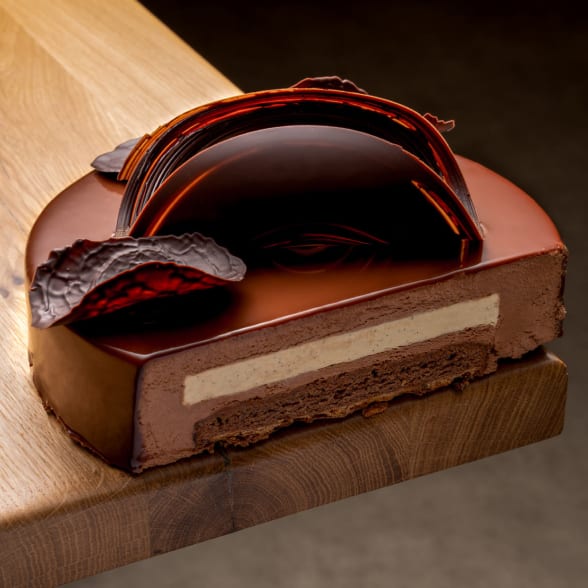
Professional Recipes
Our iconic creations will allow you to renew your offer by revisiting the great classics of pastry-making but also by offering you inspiring recipes to work with the raw material that is chocolate.
Contents :
Milk chocolate stands out from other chocolates for its incredible mellowness and incomparable melting texture. It delights people of all ages and helps you make irresistibly delicious creations. Here, Valrhona shares milk chocolate’s every last secret with you.
Swiss chocolatier Daniel Peter invented milk chocolate in 1875. Since then, it has become one of the most popular types of chocolate in the world. But do you know exactly what goes into this meltingly textured and indulgent chocolate?
Like dark and white chocolate, milk chocolate is made from cocoa and sugar. It differs from dark chocolate because of the powdered milk that is added to its basic ingredients.
At Valrhona, recipes are developed after one or two years of research by R&D engineers, with the help of our sensory analysis panel. Today, we make more than 100 different chocolate recipes (black, white, milk and even blond). Their ingredients have to be precisely quantified to bring out each chocolate’s unique qualities.
In France and Europe, there are regulations around chocolate’s composition and what names it can be given.
Valrhona milk chocolate contains the following ingredients:
Legislation around chocolate permits the use of a natural emulsifier to improve fluidity and give the chocolate a melting texture. At Valrhona, we use sunflower lecithin.
Making a chocolate involves researching what cocoa percentage will bring out the end product’s finest qualities. We have to carefully establish a subtle balance that will reveal a singular aromatic profile as we bring out one or more terroirs’ unique characteristics.
The aromatic power of a chocolate is linked to its cocoa’s terroir of origin, its recipe and its manufacturing process. As such, it isn’t true to say that a chocolate is automatically better if its cocoa percentage is higher.
To get a better understanding of what chocolate bars’ cocoa content or percentage means, see our guide to different cocoa contents.
You might not know that milk and dark chocolate provide roughly the same amount of energy (about 500 kcal per 100g). Milk chocolate is more sugary, but dark chocolate’s fat content is higher (because it is richer in beans and cocoa butter). So the higher a chocolate’s cocoa percentage, the more calorific it is. Milk chocolate is often lower in calories than dark chocolate because it is lower in fat.
Milk chocolate can be used in many ways. Whether it’s enjoyed as a snack-time chocolate bar or used to design elaborate, delicious desserts made of couverture chocolate fèves (which is what we at Valrhona call our chocolate drops), children and adults alike fall for its unmistakable sweet mellowness.
Milk chocolate for tasting and snacking
Like other chocolates, milk chocolate can be enjoyed as it is. Any chocolate specialist will tell you that there are excellent milk chocolates with complex, subtle flavors and aromas. Some people love milk chocolate, others love dark chocolate… and some of us love both!
So if you want to sample a good milk chocolate, the easiest thing is to buy it in bar, stick or square form. Snap off a piece of Caramélia and find yourself swept away by its comforting and creamy melt-in-the-mouth texture!
Professionals often use couverture chocolate when whipping up elaborate recipes. It is a specific type of chocolate whose uses include easy coatings for chocolate bonbons thanks to its high cocoa butter content.
There is no shortage of recipes that use milk chocolate. From cakes to biscuits, tarts, ganaches, yule logs and other desserts, there are all sorts of recipes you can explore.
Anyone who loves chocolate with a good cocoa flavor and subtle malty, vanilla notes will be tempted by Jivara 40% couverture chocolate.
For extra indulgence or creativity, milk chocolate can be combined with other ingredients.
Valrhona selects the finest cocoa beans and constantly develops its chocolate expertise so that it can offer exceptional, unique chocolates. First, the cocoa beans are carefully selected by our sourcing staff for their exceptional aromatics. Cocoa beans develop all their aromatic complexity during certain key stages in the making process before being precisely blended to create unique chocolates with superlative flavors.
Valrhona develops ethical, traceable chocolate sourced directly from more than 18,000 producers, who we support to adopt good social and environmental practices. By choosing Valrhona products, you contribute to creating a more sustainable cocoa sector, and become part of a community that's passionate about chocolate.
You are using an outdated browser. Please upgrade your browser to improve your experience and security.